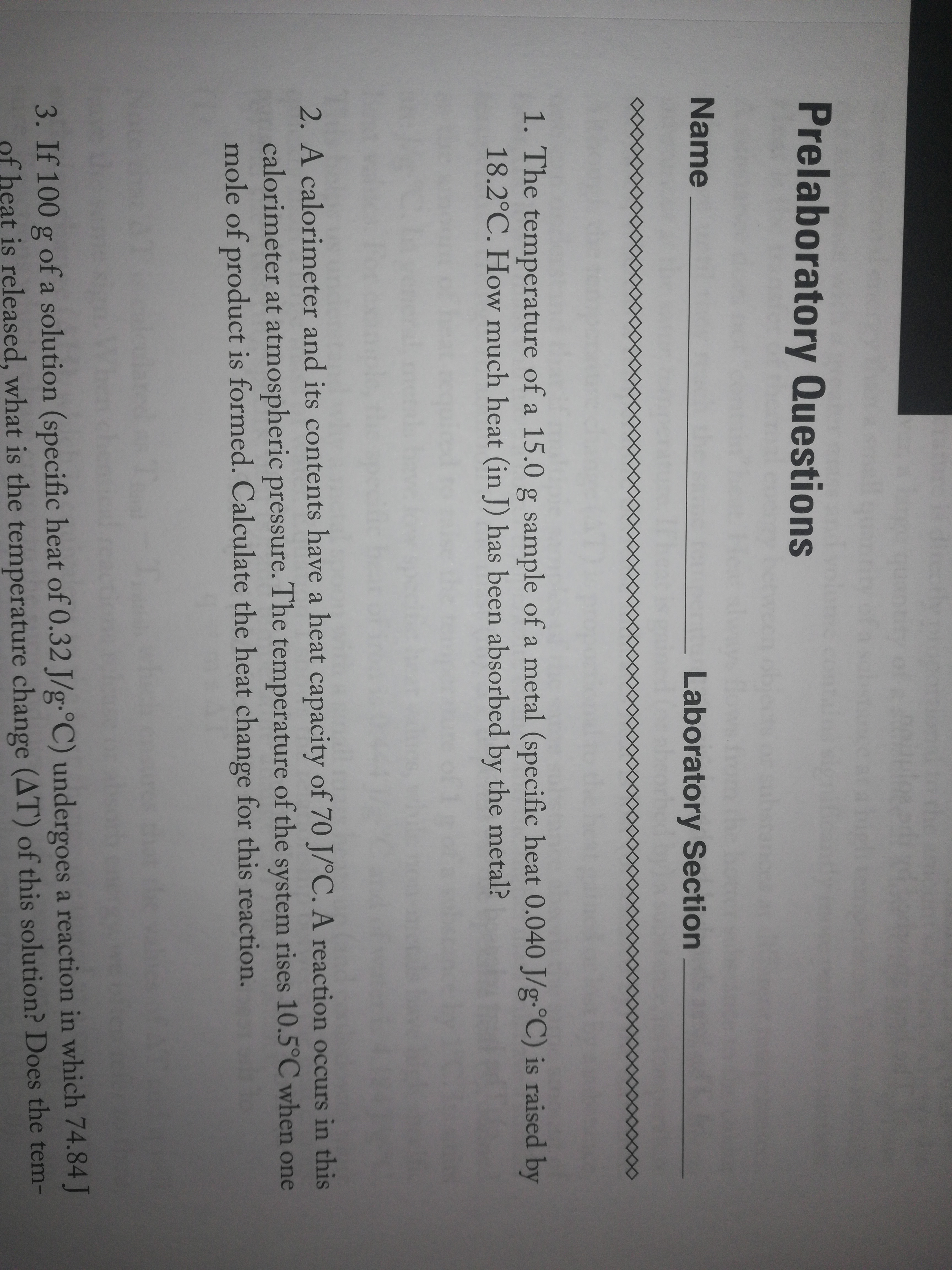Prelaboratory Questions Name Laboratory Section 8. 1. The temperature of a 15.0 g sample of a metal (specific heat 0.040 J/g-°C) is raised by 18.2°C. How much heat (in J) has been absorbed by the metal? 2. A calorimeter and its contents have a heat capacity of 70 J/°C. A reaction occurs in this calorimeter at atmospheric pressure. The temperature of the system rises 10.5°C when one mole of product is formed. Calculate the heat change for this reaction. 3. If 100 g of a solution (specific heat of 0.32 J/g-°C) undergoes a reaction in which 74.84 J of heat is released, what is the temperature change (AT) of this solution? Does the tem-
Prelaboratory Questions Name Laboratory Section 8. 1. The temperature of a 15.0 g sample of a metal (specific heat 0.040 J/g-°C) is raised by 18.2°C. How much heat (in J) has been absorbed by the metal? 2. A calorimeter and its contents have a heat capacity of 70 J/°C. A reaction occurs in this calorimeter at atmospheric pressure. The temperature of the system rises 10.5°C when one mole of product is formed. Calculate the heat change for this reaction. 3. If 100 g of a solution (specific heat of 0.32 J/g-°C) undergoes a reaction in which 74.84 J of heat is released, what is the temperature change (AT) of this solution? Does the tem-
Chemistry
10th Edition
ISBN:9781305957404
Author:Steven S. Zumdahl, Susan A. Zumdahl, Donald J. DeCoste
Publisher:Steven S. Zumdahl, Susan A. Zumdahl, Donald J. DeCoste
Chapter6: Thermochemistry
Section: Chapter Questions
Problem 49E: The overall reaction in a commercial heat pack can be represented as 4Fe(s)+3O2(g)2Fe2O3(s)H=1652KJ...
Related questions
Question
100%
1

Transcribed Image Text:Prelaboratory Questions
Name
Laboratory Section
8.
1. The temperature of a 15.0 g sample of a metal (specific heat 0.040 J/g-°C) is raised by
18.2°C. How much heat (in J) has been absorbed by the metal?
2. A calorimeter and its contents have a heat capacity of 70 J/°C. A reaction occurs in this
calorimeter at atmospheric pressure. The temperature of the system rises 10.5°C when one
mole of product is formed. Calculate the heat change for this reaction.
3. If 100 g of a solution (specific heat of 0.32 J/g-°C) undergoes a reaction in which 74.84 J
of heat is released, what is the temperature change (AT) of this solution? Does the tem-
Expert Solution
This question has been solved!
Explore an expertly crafted, step-by-step solution for a thorough understanding of key concepts.
This is a popular solution!
Trending now
This is a popular solution!
Step by step
Solved in 4 steps with 2 images

Knowledge Booster
Learn more about
Need a deep-dive on the concept behind this application? Look no further. Learn more about this topic, chemistry and related others by exploring similar questions and additional content below.Recommended textbooks for you

Chemistry
Chemistry
ISBN:
9781305957404
Author:
Steven S. Zumdahl, Susan A. Zumdahl, Donald J. DeCoste
Publisher:
Cengage Learning


Chemistry: An Atoms First Approach
Chemistry
ISBN:
9781305079243
Author:
Steven S. Zumdahl, Susan A. Zumdahl
Publisher:
Cengage Learning

Chemistry
Chemistry
ISBN:
9781305957404
Author:
Steven S. Zumdahl, Susan A. Zumdahl, Donald J. DeCoste
Publisher:
Cengage Learning


Chemistry: An Atoms First Approach
Chemistry
ISBN:
9781305079243
Author:
Steven S. Zumdahl, Susan A. Zumdahl
Publisher:
Cengage Learning

World of Chemistry
Chemistry
ISBN:
9780618562763
Author:
Steven S. Zumdahl
Publisher:
Houghton Mifflin College Div

Chemistry: The Molecular Science
Chemistry
ISBN:
9781285199047
Author:
John W. Moore, Conrad L. Stanitski
Publisher:
Cengage Learning

Chemistry by OpenStax (2015-05-04)
Chemistry
ISBN:
9781938168390
Author:
Klaus Theopold, Richard H Langley, Paul Flowers, William R. Robinson, Mark Blaser
Publisher:
OpenStax